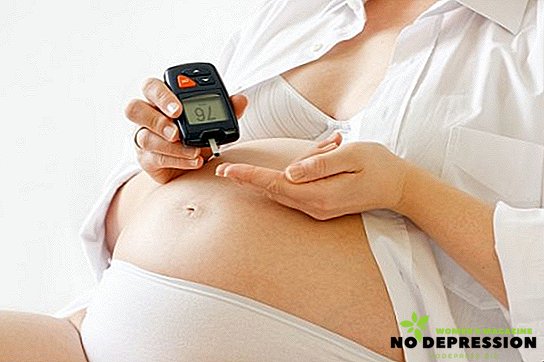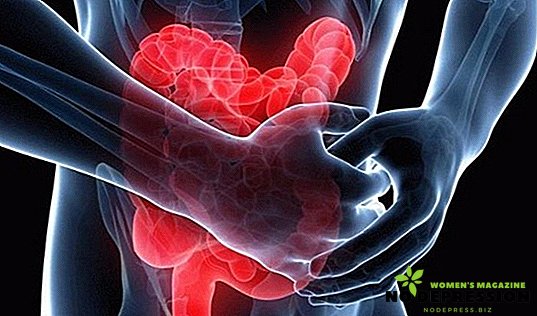After the onset of pregnancy, a woman must be required to register, undergo an ultrasound and other diagnostic procedures. Approximately 4-6% of women in this period are faced with a slight increase in blood glucose. This condition is called gestational diabetes. With early diagnosis, mother and baby are not at risk, and after giving birth, this form of diabetes goes away on its own. For this reason, it is so important to identify the problem in time.

How does gestational diabetes occur?
When carrying a child in the female body there are serious hormonal changes, as a result of which a violation of glucose tolerance may occur. What does it mean? The level of sugar in the blood is growing, but it is not enough to make such a diagnosis as diabetes.
As a result of such hormonal changes, gestational diabetes begins to develop, the mechanism of which is the following: the pancreas begins to produce 2-3 times more insulin to compensate for the sugar in the blood. If the body does not cope with its function, this disease occurs.
There are also other risks that may increase the likelihood of gestational diabetes.
 These include:
These include:
- overweight, especially if the weight was large in a woman before pregnancy;
- nationality, for example, among African Americans, Asians, the risk is higher;
- high sugar levels;
- problems with glucose tolerance;
- heredity;
- previous birth of a large child.
If you find yourself in some of the above symptoms, you should inform your doctor, who will most likely order additional research.
How is the diagnosis?
The patient will be asked to pass an analysis - oral glucose tolerance test. It passes as follows: you should drink sweetened liquid, which will contain 50 grams of sugar.
After 20-30 minutes, the patient will take blood from a vein. When studying analyzes, specialists will find out how well the body metabolizes a sweet solution, assimilating glucose.
If the analysis shows a figure above 140 mg / dL (7.7 mmol / L), this is a fairly high level. Additionally, you can schedule a second analysis, but after 2-3 hours of fasting.
What will help with this diagnosis?
To cope with this disease, you need to do the following:
- monitor blood sugar levels 4 times a day, for the first time on an empty stomach, then two hours after each meal;
- pass urine tests - ketone bodies should not be present;
- observe a special diet prescribed by a doctor (we will talk about diets below);
- do not forget to control body weight, remember about the required physical activity;
- engage in insulin therapy as needed;
- control blood pressure.

Important nutritional guidelines
If you detect gestational diabetes, you will have to revise your diet, this is one of the most important conditions for successful treatment. With this form of diabetes, it is usually necessary to reduce body weight, but pregnancy is not a time for losing weight, since the body of the mother and the fetus must receive all the necessary nutrients. You just need to reduce the caloric content of food, without reducing its nutritional value.
Other recommendations:
- You need to eat in small portions about three times a day, another 2-3 times should be done snacks, and at the same time. Skip meals can not. An important point - the first meal should consist of 45% of carbohydrates.
- Try to avoid fatty, fried foods that contain easily digestible carbohydrates, because such foods are quickly absorbed, which leads to an increase in blood sugar levels.
- If you feel sick in the morning, then you need to keep crackers or salty dry biscuits around the bed.
- You should not consume fast food products that are pre-processed to reduce cooking time, and their effect on increasing the glycemic index is higher than that of other products.
- Include in your diet foods that contain a lot of fiber. It can be pasta, rice, fruits, vegetables. Fiber stimulates the bowels, slows the absorption of fats and sugars.
- Eat a small amount of foods that contain fats: smoked meats, sausages, and sausages. It is better to replace with natural meat, and it is desirable to cook for a couple.
- On the day, drink at least 1.5 liters of water.
- Include in the diet more foods such as tomatoes, cucumbers, mushrooms, zucchini, lettuce, cabbage.

If diet therapy does not help and the sugar level does not change, ketone bodies will be detected in the blood, the doctor may prescribe insulin therapy.
What exercise will help?
Many people think that physical exercises during pregnancy will not help, but with their help you can maintain muscle tone, restore the body after childbirth, and easy gymnastics will improve the effect of insulin - all this together helps to maintain optimal blood sugar levels.
It is best to engage in activities that you like: light gymnastics, walking, exercise in water, swimming. The main thing is to avoid the load on the stomach. Also avoid dangerous forms of physical activity that can cause injuries, falls.
With the passage of insulitotherapy, it is important to remember that during exercise, hypoglycemia may occur, because before and after workouts it is necessary to check blood sugar levels. In this case, you need to take a little sugar or juice with you in case of a sharp decrease in the level of glucose.
Births with gestational diabetes
There is good news - in most cases, gestational diabetes goes away after giving birth. True, the childbirth itself can become much more complicated due to the fact that the child may be born too large.
In addition, with such diabetes, babies are usually born with low blood sugar levels, but this is fairly easy to correct with proper feeding. If the mother does not have her own milk, you need to use special mixtures.

It is also important to constantly monitor the level of sugar, especially before feeding and after two hours.
Most often, no special measures are required to normalize blood sugar levels: in children, it usually returns to normal during feeding, and in mothers, after the placenta has come out, which is an irritating factor that produces hormones.
True, the first few months you should also follow the diet, not forgetting to measure the level of sugar.
As a rule, no special measures are needed to normalize the blood sugar level of the mother and the child: the child's sugar returns to normal due to feeding, and the mother - with the release of the placenta, which is an "irritant" because it produces hormones. The first time after childbirth you will have to follow the diet and periodically measure the level of sugar, but over time, everything should return to normal.
Prevention Tips
If you already had gestational diabetes during a previous pregnancy, then the probability of the disease returning is very high. However, it is always possible to reduce the risk of developing pathology. The main rule is to maintain normal weight. It is also necessary to perform physical activity: you can go for yoga for example. It is important that the exercises do not cause discomfort.
After giving birth, women still have a risk of developing type 2 diabetes. Therefore, after giving birth, you need to listen to your health, do not take drugs that increase insulin resistance: these include funds for nicotinic acid, glucocorticoid drugs, for example, Prednisolone.
Also, some contraceptive drugs can cause diabetes, such as Progestin. Therefore, in choosing a means for contraception it is recommended to follow all the prescriptions of doctors.












